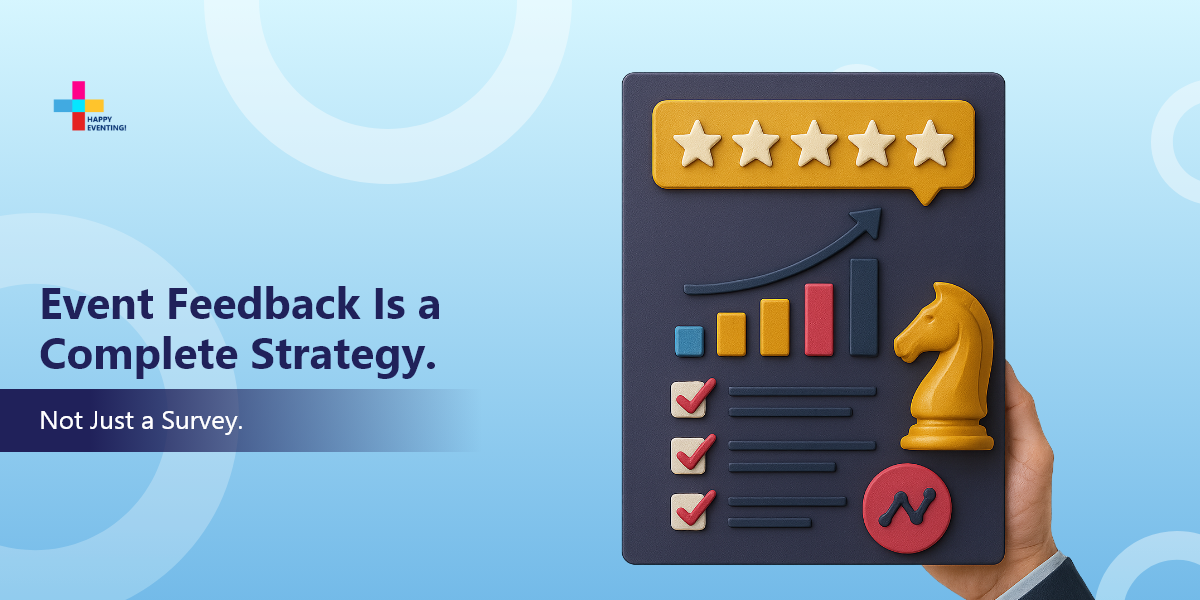

- {{UserName()}}
Request a Demo




In the corporate event world, your audience won’t always spell it out unless you ask.
A small but unique experience like a surprise wellness lounge or a speaker casually joining attendees for lunch can turn into the highlight people remember and talk about. At the same time, one flat panel or a disengaged sponsor can quietly chip away at your brand.
Event feedback is how you catch the difference.
It’s how smart organizers restructure, strategize, and stay ahead. It protects your reputation, proves ROI, and helps turn first-time attendees into loyal promoters.
This guide walks you through a step-by-step system to collect event feedback that matters. You'll learn how to ask the right event feedback questions, design effective event feedback forms, and run targeted event feedback surveys. From pre-event check-ins to post-event wrap-ups, you’ll know exactly how to get feedback from an event and use it to make the next one even better.
Event feedback isn't something you collect once and move on from. It needs to be planned before, during, and after the event, because participants’ expectations keep changing.
And it’s not just about attendees.
When you treat feedback like a continuous conversation, not a last-minute form, you:
And that’s what keeps people coming back. Not just the content, but how you respond to what they need.
So, designing event feedback strategy begins with understanding what each participant expects. Let's simplify it for you.
The fix is simple but powerful: collect event feedback at different stages.
To collect the kind of event feedback that actually improves your outcomes, timing is everything. Pre-event feedback helps align the event with audience expectations, during-event feedback captures real-time responses and engagement, and post-event feedback reveals overall impact and areas for improvement.
Here's how to get the most out of each phase.
Pre-event feedback is the input you gather from attendees, sponsors, and internal teams before the event. It helps you understand what people want and turns guesswork into a clear direction, so you can build an agenda, format, and experience that people want.
A pre-event feedback survey gives you the clarity to customize the event experience before anything is set in stone.
Questions for Pre-Event Feedback
Asking the right questions leads to the right insights. Each question should give you something specific you can act on. Here are the sample questions your pre-event feedback can use:
1. What are your top three goals for attending?
☐ Networking
☐ Learning
☐ Product discovery
Insight: Helps prioritize agenda topics and networking formats.
2. How important is access to industry leaders?
1 – Not important
2 – Slightly important
3 – Moderately important
4 – Very important
5 – Extremely important
Insight: Guides speaker selection and VIP experience planning.
3. What session format do you prefer?
○ Keynotes
○ Panels
○ Workshops
Insight: Shapes the event structure for better engagement.
4. What is one challenge you hope this event solves?
(Open-ended response)
Insight: Reveals real attendee pain points to address in content.
5. Do you prefer in-person, virtual, or hybrid attendance?
○ In-person
○ Virtual
○ Hybrid
Follow-up: Please explain why?
Insight: Helps determine the right format and tech requirements.
Executing Pre-Event Feedback
All your planning only works if the execution is on point. Here’s what helps make pre-event feedback actually usable.
During-event feedback is the real-time input you gather while the event is happening. It helps you spot what's working, fix issues on the fly, and keep attendees engaged.
Benefits of During-Event Feedback
Real-time feedback lets you pivot mid-event and builds credibility among stakeholders.
Questions for During-Event Feedback
Asking questions during the event needs careful timing so attendees stay engaged without getting distracted.
Here are some possible questions you can use :
1. Which session has been most valuable so far?
○ Keynote
○ Workshop
○ Breakout
Insight: Identifies high-impact content to replicate.
2. How would you rate the networking opportunities today?
1 – Poor
2 – Fair
3 – Good
4 – Very Good
5 – Excellent
Insight: Highlights gaps in connection-building activities.
3. What moment stood out most during the event?
(Open-ended response)
Insight: Pinpoints memorable moments to amplify.
4. How easy is it to navigate a venue or virtual platform?
1 – Very difficult
2 – Difficult
3 – Neutral
4 – Easy
5 – Very easy
Insight: Surfaces usability gaps or tech hiccups that need quick attention.
5. Any suggestions for improving the rest of the event?
(Open-ended with optional follow-up)
Insight: Offers real-time ideas for quick wins.
Executing During-Event Feedback
This is a little challenging for obvious reasons, but even a handful of responses can help you steer the event in a better direction.
Post-event feedback helps you understand what hit the mark, what missed, and what needs improvement for next time. It gives you insight into attendee satisfaction, content impact, and overall experience. This is where long-term value and repeat attendance are built.
Benefits of Post-Event Feedback
Post-event surveys give a full picture, guiding future improvements and proving ROI.
Questions for Post-Event Feedback
Post event questions help capture honest reflections while the experience is still fresh. They uncover the complete picture.
Design questions for comprehensive insights:
1. How likely are you to recommend this event to a colleague or friend?
1 – Not at all likely
10 – Extremely likely
Insight: Measures overall satisfaction and advocacy (Net Promoter Score).
2. Which session format was most engaging?
○ Panels
○ Demos
○ Q&A
Insight: Guides future content planning based on engagement.
3. What was your biggest takeaway from the event? (Open-ended response)
Insight: Reveals the core value delivered to attendees.
4. How satisfied were you with logistics such as registration, communication, or venue?
1 – Very dissatisfied
2 – Dissatisfied
3 – Neutral
4 – Satisfied
5 – Very satisfied
Insight: Identifies operational strengths and areas for improvement.
5. What would make you return to this event next year?
(Open-ended follow-up)
Insight: Shapes meaningful changes to improve retention and repeat attendance.
Executing Post-Event Feedback
Post-event feedback must not push the audience to unsubscribe or feel overwhelmed. While it needs to be fresh, don't rush it too much. Make it concise and laser-focused to get more responses without overwhelming your audience.
Now that you know when to collect feedback, here’s how to design forms that work for each group. Tailoring your feedback questions to each group helps you gather more useful and actionable insights.
Custom forms for attendees, sponsors, and exhibitors ensure relevant insights. Pre-event forms align expectations, during-event forms enable real-time tweaks, and post-event forms inform long-term planning. Timing maximizes accuracy: early for intent, mid-event for adjustments, and post-event for reflection.
1. Attendee Feedback on Experience, Sessions, and Logistics
Attendees are the heart of your event, and their feedback offers direct insight into what worked and what needs improvement. Focus on three key areas:
Experience covers their overall impression: was the event valuable, enjoyable, and worth their time? This tells you whether you met expectations and built enough trust to bring them back.
Sessions reveal which topics and formats hit the mark. Ask what they found most useful or engaging to guide your content and speaker choices for future events.
Logistics includes everything from registration and check-in to venue layout and tech. These operational details may seem small, but they shape how polished and efficient the event feels.
2. Sponsor Feedback on Visibility, Engagement, and Value
Sponsors invest in your event with clear expectations—and their feedback shows whether you delivered. Focus on three key areas:
Visibility captures how well their brand was showcased across channels, signage, and sessions. Ask if they felt seen by the right audience.
Engagement looks at the quality of interactions they had—booth visits, session shoutouts, or direct networking. This tells you whether you created real opportunities for connection.
Value reflects the return on their investment. Did they generate leads, build relationships, or gain brand traction? Their answers will guide how you structure future sponsor packages.
3. Exhibitor Feedback on Booth Traffic, Leads, and Support
Exhibitors judge your event by the business it brings and the support they receive along the way. Their feedback reveals what delivered value and what needs rethinking.
Booth traffic shows how well the event drew attendees to their space. Ask if the location, timing, and layout worked to attract the right crowd.
Leads are the real measure of success. Find out if they connected with qualified prospects and had meaningful conversations that could turn into business.
Support covers the experience you gave them as a partner—from setup and communication to on-site help. Responsive, hands-on support often decides whether exhibitors return or walk away.
Designing the event feedback form is about asking the right questions in the simplest way possible. A well-structured form improves response rates and gives you clear, actionable insights without overwhelming your audience.
Start with broad questions, like overall satisfaction, then focus on specifics, like session feedback. Cap your forms at 10 to 12 questions, grouped by theme, like content or logistics, for smooth flow.
Choose the right question types for effective insights. Use multiple-choice questions to categorize preferences quickly, rating scales (1–5 or 1–10) to measure satisfaction, and limit open-ended questions to two or three per form. Add follow-up questions to gather deeper input without overwhelming respondents.
Make 2 to 3 questions mandatory, like NPS or key satisfaction ratings. Mark others optional to respect time. Label mandatory fields clearly: "Required for key insights."
Use a friendly tone: "Your feedback makes [Event Name] better!" Ensure mobile optimization with large buttons, minimal scrolling, and fast load times. Test on iOS and Android devices.
Collecting feedback is just the start—real value comes from how you analyze and act on it. To get a full picture of event performance, combine quantitative metrics with qualitative insights. This approach helps you uncover what worked, what didn't, and why.
Tracking quantitative metrics helps measure overall satisfaction, loyalty, and audience interaction effectively.
Net Promoter Score (NPS)
Customer Satisfaction (CSAT)
Engagement Metrics
Even with the best intentions, feedback efforts can fall flat if not done right. Here are three common mistakes that reduce impact—and how to avoid them.
Long surveys and poor timing are the biggest killers of response rates. Attendees are more likely to respond when the event is fresh in their minds, and the survey is quick to complete.
Fix it: Limit post-event forms to 10 to 12 focused questions and send them within 24 hours of the event ending.
Vague or overly broad questions don't help you improve. "Did you like the event?" tells you nothing actionable.
Fix it: Ask targeted questions like, "How useful was the keynote for your current role?" or "What would have made networking more effective for you?" Specifics lead to real insights.
Nothing erodes trust faster than asking for feedback and doing nothing with it. Attendees want to feel heard.
Fix it: Build a simple action plan with clear timelines. Even small changes matter—and communicating those changes is key. For example: "You asked for faster check-in. We're introducing mobile badge pickup next year."
Getting high-quality feedback is not just about asking questions. It's about making people want to answer them. These strategies help increase response rates while building trust and long-term engagement.
Offer something valuable in return for their time. Even small gestures can go a long way.
When and how often you ask matters as much as what you ask.
Feedback should feel like a conversation, not a transaction. Show attendees their voices matter.
Feedback is the pulse of your event-it keeps it alive and thriving. Listening before, during, and after creates experiences that attendees, sponsors, and exhibitors can't stop talking about. Start small, act on insights, and watch your event become a B2B powerhouse. Ready to streamline feedback?
Eventcombo, an all-in-one event platform, makes surveys, analytics, and engagement effortless.
Book a demo to elevate your next corporate event.
What is the best way to get feedback from an event?
Combine pre, during, and post-event surveys tailored for attendees, sponsors, and exhibitors. Use mobile-friendly formats, like QR codes or apps, and act on insights to build trust.
How do you handle negative feedback?
Thank respondents, address concerns privately via email within 48 hours, and outline solutions. Share updates on changes to rebuild trust.
How can feedback improve future events?
Feedback spots wins, like popular keynotes, and gaps, like tech issues. Combine NPS, CSAT, and qualitative data to refine content, streamline operations, and prove value to leadership.

Three days. One roof. A year’s worth of networking and deals. That's IMEX America 2025, returning to the Mandalay Bay Convention Center October 7–9, and it's where the global meetings, events, and incentive travel...

In the corporate event world, your audience won’t always spell it out unless you ask. A small but unique experience like a surprise wellness lounge or a speaker casually joining attendees for lunch can turn into the...

You don't get second chances with live experiences. One missed cue, one failed handoff, and months of work can go sideways. Events are no longer just supporting functions or checkboxes—they are central to brand trust,...